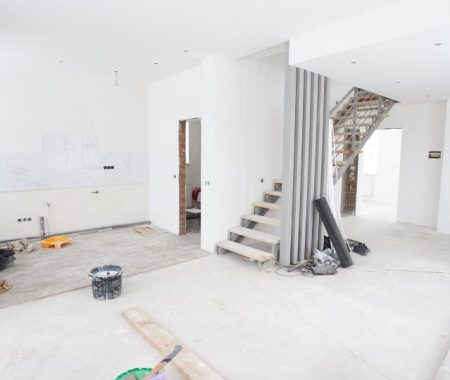Master techniques for a flawless paint job.
Painting your home is a fulfilling project that offers the opportunity to rejuvenate your living space and give it a fresh, updated look. While it might appear to be a simple task, achieving a professional finish demands meticulous planning and a keen eye for detail. From preparing the space and choosing the right paint to mastering painting techniques and completing the finishing touches, every step plays a crucial role in the final outcome. Whether you’re updating a single room or undertaking a whole-house makeover, these comprehensive painting tips will guide you through the process and help ensure a flawless, high-quality result.
To achieve a smooth and professional paint finish, start by ensuring your walls are properly prepared. Clean the surface to remove dust and dirt, and repair any cracks or holes with spackle or joint compound. Sand the repaired areas to create a smooth, even surface, and apply a primer if needed to enhance paint adhesion and coverage.
When painting, use high-quality brushes and rollers suited for your wall texture. Apply paint in thin, even coats, allowing each coat to dry completely before applying the next. Maintain a wet edge by blending the new paint with the wet paint you’re working on to avoid visible lines and streaks. This method ensures a flawless, professional-looking finish.
Before you even open a can of paint, preparation is key. Here’s what you need to do:
Clear the Room: Remove all furniture and cover any remaining items with drop cloths. This will protect your belongings from paint splatters and ensure you have plenty of room to work. If you can’t move larger items, make sure to cover them well.
Clean the Walls: Dust and dirt can prevent paint from adhering properly. Wipe down your walls with a damp cloth and let them dry completely. If your walls are particularly dirty or greasy, use a mild detergent solution.
Repair Any Damage: Inspect your walls for any cracks, holes, or imperfections. Use a spackle or joint compound to fill these areas. For larger holes, you may need a patch. Once the repairs are dry, sand them smooth so they blend with the rest of the wall.
Tape Off Areas: Painter’s tape is your best friend. Use it to tape off edges around windows, doors, baseboards, and any other areas you don’t want to paint. Make sure to press down the tape firmly to prevent paint from bleeding underneath.

Choosing the right paint is essential for achieving a professional finish and ensuring durability. Start by selecting a paint that suits the specific needs of your project. For instance, high-traffic areas like hallways or kitchens benefit from paints with higher durability and washability, such as satin or semi-gloss finishes. On the other hand, low-traffic areas can be effectively covered with matte or eggshell finishes, which offer a softer look and help conceal imperfections.
Additionally, consider the color carefully, as it greatly affects the ambiance of a room. Test sample swatches on your walls and observe them at different times of the day to see how they change with natural and artificial light. Opting for high-quality paint brands can also make a significant difference, offering better coverage, longer-lasting results, and a more even application.
Gathering the right tools is crucial for achieving a smooth and professional paint job. Start with essential items like high-quality paintbrushes and rollers, which are designed for specific tasks. Angled brushes are perfect for cutting in around edges and trim, while rollers with the appropriate nap length are ideal for covering large wall areas efficiently. A paint tray helps in evenly distributing paint on your roller, ensuring consistent coverage.
Additionally, don’t forget other helpful tools like painter’s tape for clean lines, drop cloths to protect floors and furniture, and an extension pole to reach high areas without a ladder. Investing in these tools ensures that your painting project is not only easier but also yields a more polished and professional finish.
Mastering painting techniques is essential for achieving a flawless finish. Begin by “cutting in” with a brush around edges, corners, and trim to create clean, sharp lines. This step ensures that roller coverage won’t accidentally overlap onto areas you want to keep paint-free. Use an angled brush for precision and apply paint in smooth, even strokes.
When using a roller, start with a “W” pattern to distribute the paint evenly and avoid streaks. Work in sections, blending each section while the paint is still wet to maintain a consistent look. Always keep a wet edge to prevent noticeable lines where two sections meet. Following these techniques will help you achieve a professional and smooth paint job.
Achieving a perfect home paint job involves a well-planned approach. Start by thoroughly preparing the room: remove furniture, cover floors and fixtures with drop cloths, and clean the walls to eliminate dust and grime. Repair any imperfections like cracks or holes with spackle, then sand the areas smooth. Apply painter’s tape to protect edges and trim from stray paint.
Next, choose high-quality paint and tools suitable for your project. Begin by cutting in around edges with a brush, then use a roller to cover larger wall areas. Apply paint in thin, even coats, allowing each coat to dry before adding another. Remove painter’s tape while the paint is still slightly wet to ensure crisp lines, and perform any necessary touch-ups for a flawless finish.
To achieve a beautiful paint job, mastering essential techniques is key. Start by properly preparing the surface: clean the walls, patch any imperfections, and sand them smooth. Apply a primer if necessary to ensure even paint adhesion. When painting, use high-quality brushes and rollers suited for your wall texture. Begin with “cutting in” around edges and corners with a brush to create clean lines before using a roller on larger areas.
Apply paint in thin, even coats to avoid drips and uneven coverage. Use a “W” pattern with your roller to spread paint evenly and maintain a wet edge to blend each section seamlessly. Allow each coat to dry thoroughly before applying additional layers for the best results.
Achieving a professional finish in a home painting project requires a combination of careful preparation, the right materials, and a bit of technique. By following the steps outlined—from preparing the space and selecting quality paint to mastering application techniques and avoiding common mistakes—it’s possible to ensure a smooth and flawless result. Patience and attention to detail are crucial for a paint job that not only looks great but also stands the test of time.
For those seeking expert assistance to achieve the perfect paint finish, EGL Construction Inc is available to help. Based in Glenview, this team of professionals is dedicated to delivering exceptional results for home improvement needs. Contact EGL Construction Inc to learn more about painting services and how to transform a space.

EGL Construction Inc delivers quality craftsmanship, specializing in residential and commercial projects, ensuring client satisfaction.
© 2024 EGL Construction Inc . All Rights Reserved. | Privacy policy | Terms and conditions